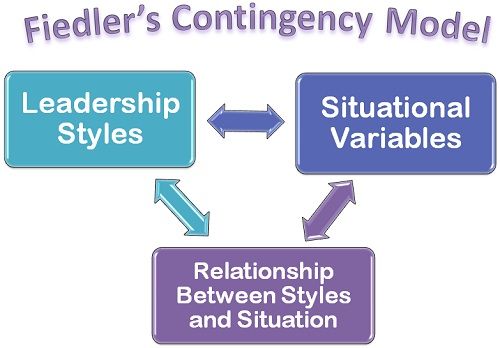Definition: Fred Fiedler was the first amongst all the leadership theorists to talk about the situational variables. According to him, the effectiveness of the leadership style depends on the situation. Thus, he along with his associates identified the situational variables and studied about their relationship with the appropriateness of leadership styles.
Fiedler’s contingency model is comprised of three elements, Viz, Leadership styles, situational variables and the relationship between styles and situation. Let’s study these in detail:

- Leadership Style: According to Fiedler, the leadership style depends on two dimensions, task-oriented and human-relations oriented. The task-oriented leader is primarily concerned with the task performance and the accomplishment of task goals. He gets satisfied with the accomplishment of task performance. While, the manager concerned with human relations lay more emphasis on developing the interpersonal relationship with his subordinates.In order to understand the attitude of a leader, Fiedler developed a “Least Preferred Co-worker Scale (LPC)”, wherein the leaders are asked to rate a person on a scale ranging from lowest (1) to highest (8) on several parameters to identify the worker with whom they least like to work. Certain parameters on the LPC scale are: pleasant/unpleasant, friendly/unfriendly, tense/relaxed, supportive/hostile, cooperative/uncooperative, quarrelsome/harmonious, etc. The leaders with high LPC scores are said to be relationship-oriented whereas the ones with the low LPC scores are considered as task-oriented.
- Situational Variables: It has been observed that, several situational factors influence the effectiveness of the leadership styles, but however, Fiedler has talked about three critical dimensions: Leader’s Position Power: This element is concerned with the power or authority a leader derives from the position held by him in the organization. It has been observed, that a manager with absolute power influences the behavior of others more than the ones without power.Task Structure: The task structure means the extent to which the task requirements are clearly defined in terms of the task goals, processes and relationship with other tasks. It has been observed, that with the clear definition of task structure the actions of the subordinates can be well directed and their performances can be well controlled, which may not be possible in case of unclear task structure.
Leader-member Relations: This dimension talks about the degree to which the members have trust, confidence and faith in their manager.
- Relation Between Styles and Situations: This is the last element of Fiedler’s contingency model, wherein he talks about the relationship between the situation and the appropriateness of leadership style. According to him, the leadership effectiveness depends on the situation, as one style favoring one situation may not necessarily be appropriate in any other situation. Thus, it is the situation that gives an opportunity to the leader to influence his subordinates through the right kind of leadership style.
Thus, Fiedler’s contingency model posits that the situation decides the style of leadership and influences the behavior of a manager.

C Baker says
Great summary of the model. An area to improve in is the inclusion of female or they in the discussion of the leadership piece. There was only ever ‘he’ as leader. Thanks for your work.